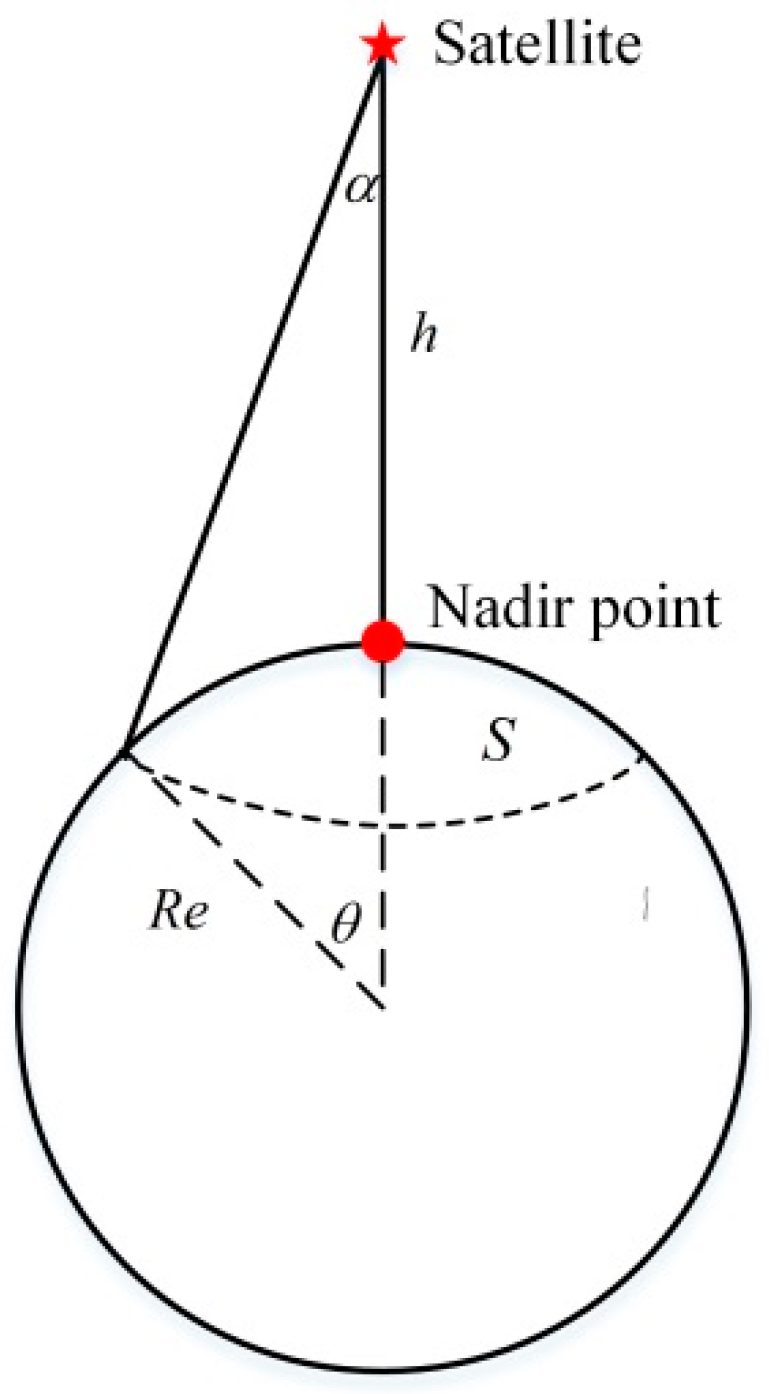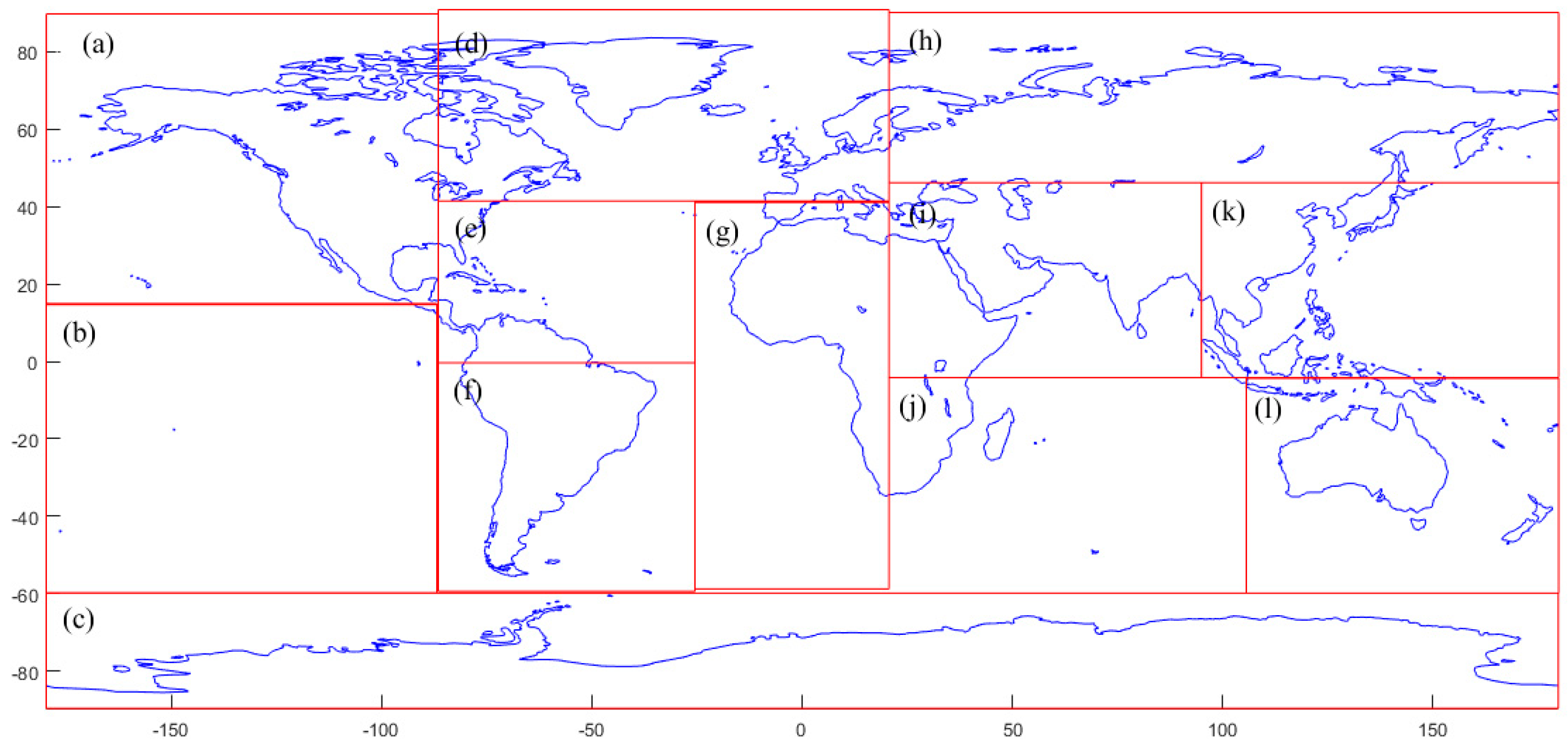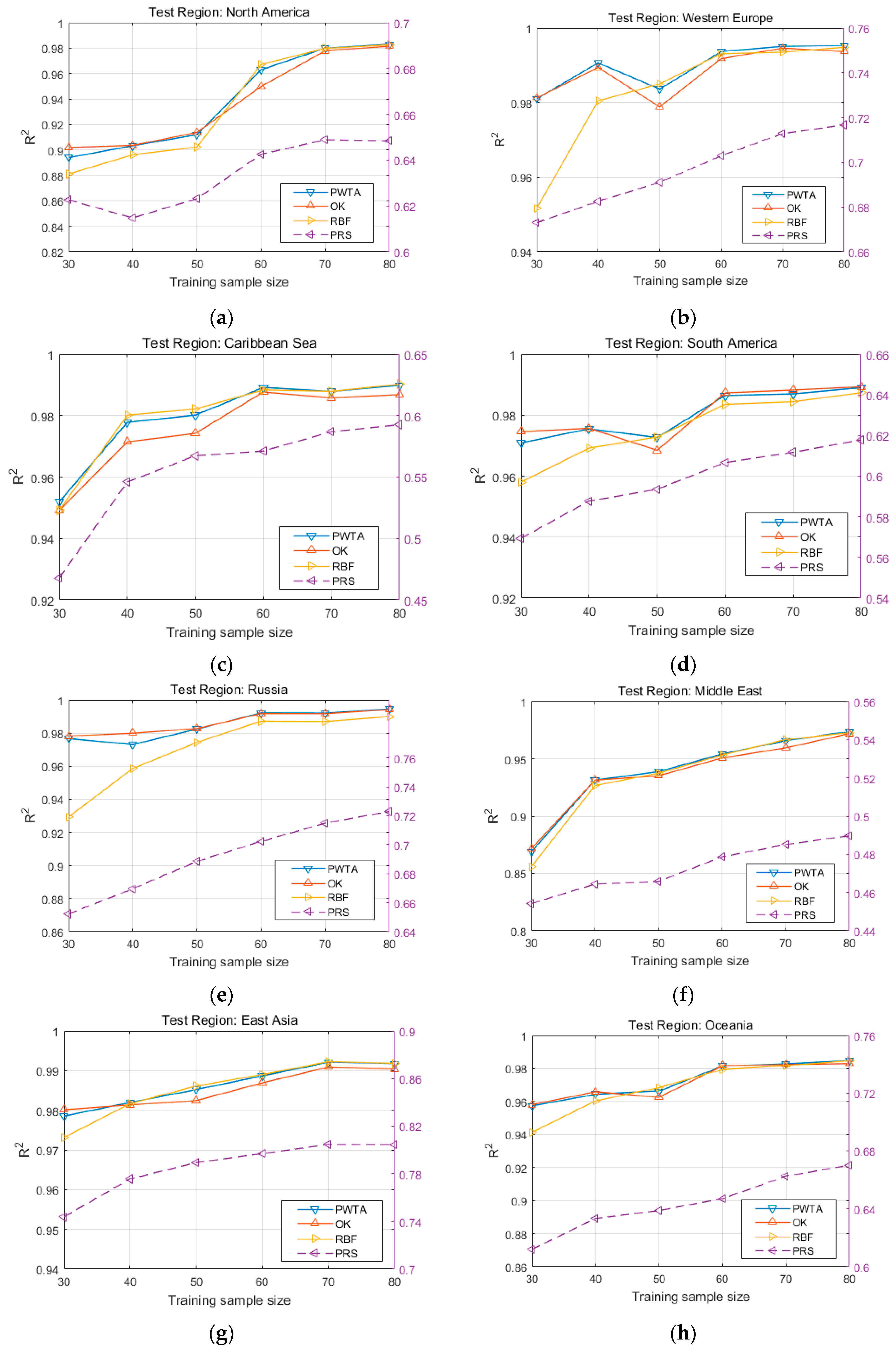An Effective Surrogate Ensemble Modeling Method for Satellite Coverage Traffic Volume Prediction
Abstract
1. Introduction
2. Preliminary
2.1. Polynomial Response Regression (PRS)
2.2. Kriging
2.3. Radial Basis Function
2.4. Weighted Aggregation Method
2.5. BestGMSE Surrogate
3. Satellite Coverage Traffic Volume Modeling and Prediction Approximation
3.1. Satellite Coverage Traffic Volume Modeling
3.2. Surrogate Ensemble Modeling for SCTV Prediction
4. Experimental Results
4.1. Experimental Setting
4.2. Effect of Design of Experiment for Training Sample Generation
4.3. Effect of the Training Sample Size
4.4. Effect of the Sub-Domain Division
4.5. Accuracy and Robustness
5. Conclusions
Author Contributions
Funding
Conflicts of Interest
References
- Bettray, A.; Litschke, O.; Baggen, L. Multi-beam antenna for space-based ADS-B. In Proceedings of the 2013 IEEE International Symposium on Phased Array Systems and Technology, Waltham, MA, USA, 15–18 October 2013; pp. 227–231. [Google Scholar]
- Fournier, M.; Casey Hilliard, R.; Rezaee, S. Past, present, and future of the satellite-based automatic identification system: Areas of applications (2004–2016). WMU J. Marit. Aff. 2018, 17, 311–345. [Google Scholar] [CrossRef]
- He, Y.; Jia, Y.; Zhong, X. A traffic-awareness dynamic resource allocation scheme based on multi-objective optimization in multi-beam mobile satellite communication systems. Int. J. Distrib. Sens. Netw. 2017, 13, 1–14. [Google Scholar] [CrossRef][Green Version]
- Yu, S.; Chen, L.; Li, S.; Zhang, X. Adaptive Multi-beamforming for Space-based ADS-B. J. Navig. 2018, 72, 359–374. [Google Scholar] [CrossRef]
- Goel, T.; Hafkta, R.T.; Shyy, W. Comparing error estimation measures for polynomial and kriging approximation of noise-free functions. Struct. Multidiscip. Optim. 2008, 38, 429–442. [Google Scholar] [CrossRef]
- Clark, D.L.; Bae, H.-R.; Gobal, K.; Penmetsa, R. Engineering Design Exploration Using Locally Optimized Covariance Kriging. AIAA J. 2016, 54, 3160–3175. [Google Scholar] [CrossRef]
- Sun, Z.; Zhang, Y.; Yang, G. Surrogate Based Optimization of Aerodynamic Noise for Streamlined Shape of High Speed Trains. Appl. Sci. 2017, 7, 196. [Google Scholar] [CrossRef]
- Yao, W.; Chen, X.; Zhao, Y. Concurrent subspace width optimization method for RBF neural network modeling. IEEE Trans. Neural Netw Learn. Syst 2012, 23, 247–259. [Google Scholar]
- Clarke, S.M.; Simpson, T.W. Analysis of Support Vector Regression for Approximation of Complex Engineering Analyses. J. Mech. Des. 2005, 127, 77–87. [Google Scholar] [CrossRef]
- Sun, G.; Song, X.G.; Baek, S.; Li, G. Crashworthiness optimization of foam-filled tapered thin-walled structure using multiple surrogate models. Struct. Multidiscip. Optim. 2013, 47, 221–231. [Google Scholar]
- Forrester, I.J.; Keane, A.J. Recent advances in surrogate-based optimization. Prog. Aerosp. Sci. 2009, 45, 50–79. [Google Scholar] [CrossRef]
- Bhosekar, A.; Ierapetritou, M. Advances in surrogate based modeling, feasibility analysis, and optimization: A review. Comput. Chem. Eng. 2018, 108, 250–267. [Google Scholar] [CrossRef]
- Wang, G.; Shan, S. Review of Metamodeling Techniques in Support of Engineering Design Optimization. ASME J. Mech Des. 2007, 129, 370–380. [Google Scholar] [CrossRef]
- Goel, T.; Haftka, R.T.; Shyy, W.; Queipo, N.V. Ensemble of surrogates. Struct. Multidiscip. Optim. 2006, 33, 199–216. [Google Scholar] [CrossRef]
- Glaz, B.; Goel, T.; Liu, L.; Friedmann, P.; Haftka, R.T. Application of a Weighted Average Surrogate Approach to Helicopter Rotor Blade Vibration Reduction. In Proceedings of the 48th AIAA/AMSE/AHS/ASC Structures, Structural Dynamic, and Materials Conference, Waikiki, HI, USA, 23–26 April 2007; pp. 1–25. [Google Scholar]
- Wang, H.; Doherty, J. Committee-Based Active Learning for Surrogate-Assisted Particle Swarm Optimization of Expensive Problems. IEEE Trans. Cybern. 2017, 47, 2664–2677. [Google Scholar] [CrossRef]
- Gu, X.; Wang, H. Reliability-based design optimization for vehicle occupant protection system based on ensemble of metamodels. Struct. Multidiscip. Optim. 2015, 51, 533–546. [Google Scholar] [CrossRef]
- Viana, F.; Steffen, V. Multiple surrogates: How cross-validation errors can help us to obtain the best predictor. Struct. Multidiscip. Optim. 2009, 39, 439–457. [Google Scholar] [CrossRef]
- Acar, E. Various approaches for constructing an ensemble of metamodels using local measures. Struct. Multidiscip. Optim. 2010, 42, 879–896. [Google Scholar] [CrossRef]
- Zhang, J.; Chowdhury, S.; Messac, A. An adaptive hybrid surrogate model. Struct. Multidiscip. Optim. 2012, 46, 223–238. [Google Scholar] [CrossRef]
- Yin, H.; Fang, H.; Wen, G.; Gutowski, M.; Xiao, Y. On the ensemble of metamodels with multiple regional optimized weight factors. Struct. Multidiscip. Optim. 2018, 58, 245–263. [Google Scholar] [CrossRef]
- Lee, Y.; Choi, D.H. Pointwise ensemble of meta-models using v nearest points cross-validation. Struct. Multidiscip. Optim. 2014, 50, 383–394. [Google Scholar] [CrossRef]
- Zhou, Z.; Wu, J.; Tang, W. Ensembling Neural Networks: Many Could Be Better Than All. Artif. Intell. 2002, 137, 239–263. [Google Scholar] [CrossRef]
- Zhang, Y.; Yao, W.; Ye, S.; Chen, X. A regularization method for constructing trend function in Kriging model. Struct. Multidiscip. Optim. 2018, 59, 1221–1239. [Google Scholar] [CrossRef]
- Qian, C.; Zhang, S.; Zhou, W. Traffic-based dynamic beam coverage adjustment in satellite mobile communication. In Proceedings of the Sixth International Conference on Wireless Communications & Signal Processing, Hefei, China, 23–25 October 2014; pp. 1–6. [Google Scholar]
- Li, S.; Chen, X.; Chen, L.; Zhao, Y.; Sheng, T.; Bai, Y. Data Reception Analysis of the AIS on board the TianTuo-3 Satellite. J. Navig. 2017, 70, 761–774. [Google Scholar] [CrossRef]
- Machado, A.; Gee, J.; Campos, M. Substructural segmentation based on regional shape differences. In Proceedings of the XV Brazilian Symposium on Computer Graphics and Image Processing, Fortaleze, CE, Brazil, 7–10 October 2002; pp. 3–10. [Google Scholar]
- Li, L.; Wen, Z.; Wang, Z. Outlier Detection and Correction During the Process of Groundwater Lever Monitoring Base on Pauta Criterion with Self-learning and Smooth Processing. In Theory, Methodology, Tools and Applications for Modeling and Simulation of Complex Systems: 16th Asia Simulation Conference and SCS Autumn Simulation Multi-Conference, AsiaSim/SCS AutumnSim 2016, Beijing, China, 8–11 October 2016; Springer: Singapore, 2016; pp. 497–503. [Google Scholar]
- Filzmoser, P.; Garrett, R.G.; Reimann, C. Multivariate outlier detection in exploration geochemistry. Comput. Geosci. 2005, 31, 579–587. [Google Scholar] [CrossRef]
- Lophaven, S.N.; Nielsen, H.B.; Søndergaard, J. Aspect of the Matlab Toolbox DACE; Report IMM-TR-2002-13; Informatics and Mathematical Modelling; DTU: Kongens Lyngby, Denmark, 2002. [Google Scholar]
- Forrester, I.J.; Sóbester, A.; Keane, A.J. Engineering Design via Surrogate Modelling: A Practical Guide; John Weily&Sons: Hoboken, NJ, USA, 2008. [Google Scholar]




| Surrogate Model | Details |
|---|---|
| PRS | The second-order polynomials are used |
| OK | A constant regression function and a Gaussian correlation model are employed in the mode. In all cases, , and , for where is the number of variables and is the vector whose entries are all equal to 1 |
| RBF | The form of basis function is the multiquadric function and we set [20] |
| PWTA | The above three models are used as the candidate surrogates. The control parameter |
| WTA | The same as PWTA |
| BestGMSE surrogate | The same as PWTA |
| Sub-Domains | No. of Test Sample Points |
|---|---|
| North America | 1680 |
| Western Europe | 1370 |
| Caribbean Sea | 695 |
| South America | 1045 |
| Russia | 1790 |
| Middle East | 930 |
| East Asia | 1060 |
| Oceania | 1025 |
| Performance Metric | Surrogate Model | North America | Western Europe | Caribbean Sea | South America | Russia | Middle East | East Asia | Oce-ania | Global Domain |
|---|---|---|---|---|---|---|---|---|---|---|
| of the models using FFD | PRS | 0.6425 | 0.7029 | 0.5712 | 0.6067 | 0.7023 | 0.4787 | 0.7968 | 0.6469 | 0.6760 |
| OK | 0.9622 | 0.9918 | 0.9877 | 0.9873 | 0.9918 | 0.9507 | 0.9869 | 0.9816 | 0.9837 | |
| RBF | 0.9671 | 0.9931 | 0.9884 | 0.9836 | 0.9872 | 0.9532 | 0.9890 | 0.9795 | 0.9830 | |
| PWTA | 0.9667 | 0.9937 | 0.9892 | 0.9866 | 0.9920 | 0.9541 | 0.9885 | 0.9814 | 0.9846 | |
| Meanof the models using LHS | PRS | 0.6266 | 0.7394 | 0.5591 | 0.6426 | 0.7307 | 0.4534 | 0.8254 | 0.7141 | 0.7021 |
| OK | 0.9111 | 0.9635 | 0.9170 | 0.9342 | 0.9439 | 0.8522 | 0.9500 | 0.9259 | 0.9332 | |
| RBF | 0.9225 | 0.9582 | 0.9376 | 0.9521 | 0.9507 | 0.9214 | 0.9825 | 0.9594 | 0.9564 | |
| PWTA | 0.9324 | 0.9735 | 0.9389 | 0.9545 | 0.9675 | 0.9107 | 0.9798 | 0.9579 | 0.9593 |
| Surrogate Model | 30 Training Points in Each Sub-Domain | 40 Training Points in Each Sub-Domain | 50 Training Points in Each Sub-Domain | 60 Training Points in Each Sub-Domain | 70 Training Points in Each Sub-Domain | 80 Training Points in Each Sub-Domain |
|---|---|---|---|---|---|---|
| PRS | 0.6333 | 0.6557 | 0.6658 | 0.6760 | 0.6855 | 0.6901 |
| OK | 0.9613 | 0.9703 | 0.9694 | 0.9831 | 0.9862 | 0.9880 |
| RBF | 0.9428 | 0.9645 | 0.9713 | 0.9830 | 0.9858 | 0.9880 |
| PWTA | 0.9596 | 0.9697 | 0.9722 | 0.9845 | 0.9872 | 0.9891 |
| Performance Metric | Surrogate Model | North America | Western Europe | Caribbean Sea | South America | Russia | Middle East | East Asia | Oce-ania | Global Domain |
|---|---|---|---|---|---|---|---|---|---|---|
| PWTASD | 0.967 | 0.994 | 0.989 | 0.987 | 0.992 | 0.954 | 0.989 | 0.981 | 0.985 | |
| PWTAGD | 0.960 | 0.992 | 0.986 | 0.978 | 0.985 | 0.946 | 0.987 | 0.970 | 0.980 | |
| NRMSE | PWTASD | 0.082 | 0.037 | 0.050 | 0.081 | 0.053 | 0.077 | 0.059 | 0.082 | 0.069 |
| PWTAGD | 0.090 | 0.043 | 0.057 | 0.104 | 0.072 | 0.084 | 0.063 | 0.104 | 0.079 | |
| NMAE | PWTASD | 0.425 | 0.155 | 0.166 | 0.372 | 0.229 | 0.282 | 0.284 | 0.418 | 0.447 |
| PWTAGD | 0.426 | 0.168 | 0.213 | 0.377 | 0.306 | 0.284 | 0.286 | 0.513 | 0.549 |
| Performance Metric | Surrogate Model | North America | Western Europe | Caribbean Sea | South America | Russia | Middle East | East Asia | Oceania | Global Domain |
|---|---|---|---|---|---|---|---|---|---|---|
| PRS | 0.6425 | 0.7029 | 0.5712 | 0.6067 | 0.7023 | 0.4787 | 0.7968 | 0.6469 | 0.6760 | |
| OK | 0.9622 | 0.9918 | 0.9877 | 0.9873 | 0.9918 | 0.9507 | 0.9869 | 0.9816 | 0.9837 | |
| RBF | 0.9671 | 0.9931 | 0.9884 | 0.9836 | 0.9872 | 0.9532 | 0.9890 | 0.9795 | 0.9830 | |
| PWTA | 0.9667 | 0.9937 | 0.9892 | 0.9866 | 0.9920 | 0.9541 | 0.9885 | 0.9814 | 0.9846 | |
| WTA | 0.9470 | 0.9688 | 0.9612 | 0.9584 | 0.9729 | 0.9184 | 0.9771 | 0.9556 | 0.9626 | |
| BestGMSE | 0.9671 | 0.9931 | 0.9884 | 0.9836 | 0.9872 | 0.9532 | 0.9890 | 0.9816 | 0.9833 | |
| NRMSE | PRS | 0.2700 | 0.2548 | 0.3131 | 0.4378 | 0.3245 | 0.2602 | 0.2515 | 0.3593 | 0.3169 |
| OK | 0.0878 | 0.0423 | 0.0530 | 0.0786 | 0.0539 | 0.0800 | 0.0639 | 0.0819 | 0.0711 | |
| RBF | 0.0819 | 0.0388 | 0.0515 | 0.0895 | 0.0673 | 0.0779 | 0.0585 | 0.0867 | 0.0727 | |
| PWTA | 0.0824 | 0.0372 | 0.0496 | 0.0808 | 0.0532 | 0.0772 | 0.0598 | 0.0824 | 0.0691 | |
| WTA | 0.1039 | 0.0825 | 0.0942 | 0.1424 | 0.0978 | 0.1029 | 0.0844 | 0.1274 | 0.1076 | |
| BestGMSE | 0.0819 | 0.0388 | 0.0515 | 0.0895 | 0.0673 | 0.0779 | 0.0585 | 0.0819 | 0.0719 |
© 2019 by the authors. Licensee MDPI, Basel, Switzerland. This article is an open access article distributed under the terms and conditions of the Creative Commons Attribution (CC BY) license (http://creativecommons.org/licenses/by/4.0/).
Share and Cite
Ye, S.; Zhang, Y.; Yao, W.; Chen, Q.; Chen, X. An Effective Surrogate Ensemble Modeling Method for Satellite Coverage Traffic Volume Prediction. Appl. Sci. 2019, 9, 3689. https://doi.org/10.3390/app9183689
Ye S, Zhang Y, Yao W, Chen Q, Chen X. An Effective Surrogate Ensemble Modeling Method for Satellite Coverage Traffic Volume Prediction. Applied Sciences. 2019; 9(18):3689. https://doi.org/10.3390/app9183689
Chicago/Turabian StyleYe, Siyu, Yi Zhang, Wen Yao, Quan Chen, and Xiaoqian Chen. 2019. "An Effective Surrogate Ensemble Modeling Method for Satellite Coverage Traffic Volume Prediction" Applied Sciences 9, no. 18: 3689. https://doi.org/10.3390/app9183689
APA StyleYe, S., Zhang, Y., Yao, W., Chen, Q., & Chen, X. (2019). An Effective Surrogate Ensemble Modeling Method for Satellite Coverage Traffic Volume Prediction. Applied Sciences, 9(18), 3689. https://doi.org/10.3390/app9183689





